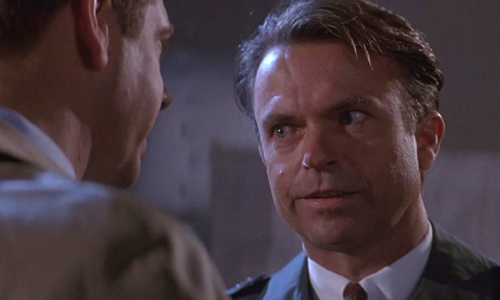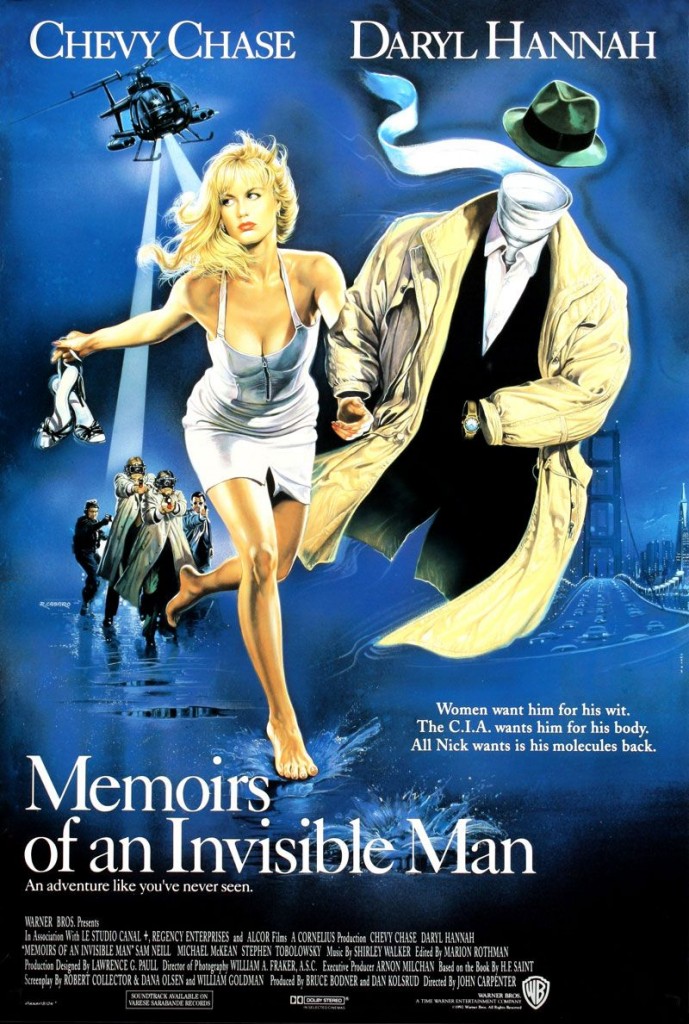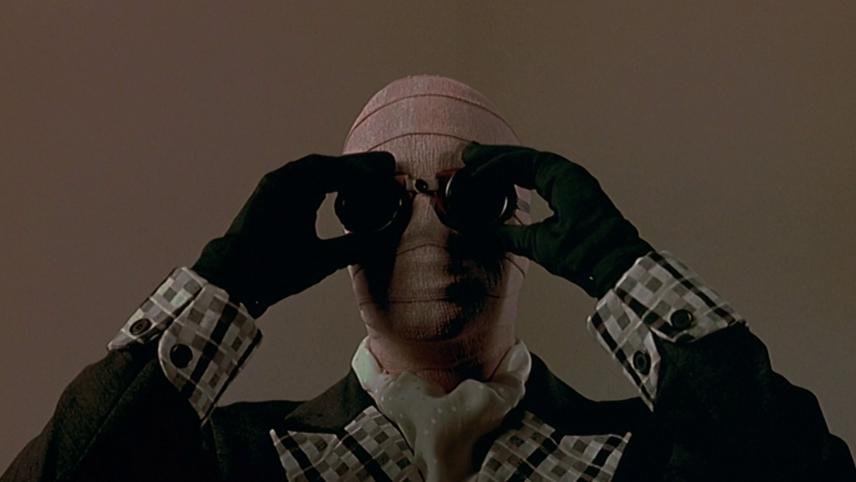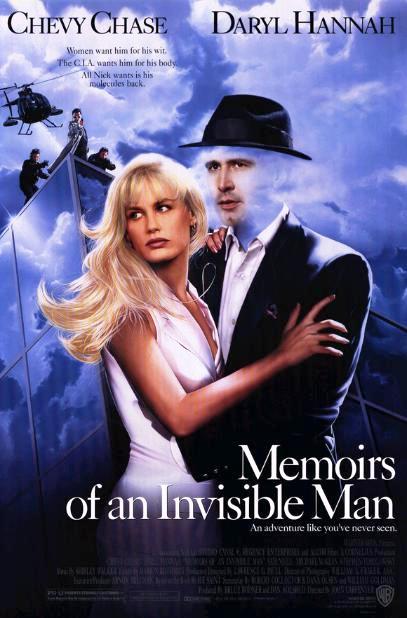The Complete Carpenter: Memoirs of an Invisible Man (1992)
The turnaround time on this installment of my John Carpenter retrospective was fast. That’s because there isn’t much to say about Memoirs of an Invisible Man. It’s the only film Carpenter directed strictly as a work-for-hire job. He came onto the film to get it shot after most of the creative pre-production decisions were already made. He didn’t take his usual above the title possessive credit, the only time that happened since Dark Star.
This article series by its nature takes an auteur approach to film analysis, and there’s not much to analyze with a movie where the director himself acknowledges he had little authorial voice in the final product. But there’s not much to analyze no matter the approach because this is a deeply mediocre movie.
Basically, if you want to skip this article and wait for In the Mouth of Madness, neither I nor John Carpenter will mind.
The Story
Chevy Chase plays Nick Halloway, a rich San Francisco investment banker who gets turned invisible by a scientific accident. Sinister government intelligence agent and hatchet man David Jenkins (Sam Neill) pursues Nick as a potential asset. Nick meets a pretty woman, Alice Monroe (Daryl Hannah), who helps him out. Eventually, Nick outwits Jenkins and goes to live in Switzerland with Alice, although he stays invisible. Roll credits.
The real story is what happened in pre-production. Memoirs of an Invisible Man was a Chevy Chase vanity project. He purchased the rights to H. F. Saint’s novel as a path to more serious leading man roles. This change in approach to what was supposed to be a comedy caused original director Ivan Reitman to jump ship, and screenwriter William Goldman (The Princess Bride and other movies far better than this one) followed soon after. Many directors were considered, and for a while Lethal Weapon’s Richard Donner was the serious contender. But then John Carpenter — not somebody you’d expect to helm a Chevy Chase movie of any type — ended up with the job. Possibly it was Carpenter’s track record working with visual effects and having directed another couple-on-the-run SF movie, Starman, that got Chase’s attention. Carpenter was engaged in a legal dispute with Alive Films at the time and decided to do the work-for-hire gig. Let’s see how that went.
The Positives
Memoirs of an Invisible Man is not the worst John Carpenter film. It has two unambiguously great elements that salvage it from complete disposability: the visual effects and Sam Neill’s villain.
Special effects were in a Phantom Zone in 1992, suspended between the CGI morphing of Terminator 2: Judgment Day and the full-motion photoreal creatures in Jurassic Park. Memoirs of an Invisible Man hits the sweet spot with its effects: they look great because they use digital compositing in combination with practical effects and required actual ingenuity to craft. The invisibility scenes create the same “wow” effect for modern audiences as John P. Fulton’s work on The Invisible Man did for audiences in 1933. If Jurassic Park hadn’t swaggered along eight months later, Memoirs of an Invisible Man would be considered a bigger digital effects landmark.
 In the 1933 Invisible Man, Claude Rains’s titular character spoke about how he couldn’t walk around invisible after he had just eaten because the food could be seen digesting in his stomach. Now we actually get to see that happen, immediately followed by what it looks like when an invisible person vomits. We also see an invisible man chew gum, smoke, and dash through the rain. The ILM effects team never passed up a chance to meet a challenge, such as Alice smearing makeup over Nick’s invisible face to create a floating eye-less mask. The sequence in the rain, where Nick’s body is outlined by shimmering drops, creates an emotional moment in a scene where the drama can’t carry it.
In the 1933 Invisible Man, Claude Rains’s titular character spoke about how he couldn’t walk around invisible after he had just eaten because the food could be seen digesting in his stomach. Now we actually get to see that happen, immediately followed by what it looks like when an invisible person vomits. We also see an invisible man chew gum, smoke, and dash through the rain. The ILM effects team never passed up a chance to meet a challenge, such as Alice smearing makeup over Nick’s invisible face to create a floating eye-less mask. The sequence in the rain, where Nick’s body is outlined by shimmering drops, creates an emotional moment in a scene where the drama can’t carry it.
The most imaginative effects work is the set for a building that has turned partially invisible because of an explosion. The design work of a structure that’s turned into swiss cheese with sections hanging impossibly in mid-air is a surreal masterpiece.
Sam Neill’s presence in Memoirs of an Invisible Man justifies its existence. If John Carpenter hadn’t met the actor on this movie, he wouldn’t have cast him in In the Mouth of Madness and we’d all be poorer for it. Even without that future outcome, Neill is fantastic as David Jenkins, ruthless CIA wetwork man. The villain in a romantic thriller-comedy is usually a toss away part. Neill, however, doesn’t just steal the movie: he takes it at gunpoint, stuffs it into a body bag, then loads it into a black helicopter. On paper, Jenkins’s motivations are unclear; he acts like a rogue agent but goes back to being CIA loyal as the scene requires. But the sinister aura Neill projects makes Jenkins frightening and the closest thing the movie has to a spine. In the film’s best line, delivered to Jenkins’s supposed CIA superior (Stephen Tobolowsky), Neill sharply defines who the character is: “A little reminder of the state of things might be in order. I’m the one that kills people … not you.”
Jenkins is the most John Carpenter figure in the movie: an independent operator and an “Awareness Character” who shares much in common with Snake Plissken in how he perceives situations, rapidly analyzes them, and then takes the most brutal and effective approach. I’d rather watch a movie about an antihero Sam Neill tracking down a dozen fugitive invisible people and trapping them one by … damn, now I’m writing my own Carpenter fanfic.
There’s not much of John Carpenter stylistic flourishes, but the director has a firm grasp on blocking and shooting the movie to prevent confusion about Nick switching between being visible or invisible to the audience. Creating this balance is trickier than it looks, and Carpenter’s execution makes the process, well, invisible.
The Negatives
 You rarely read articles about movies of this caliber — i.e. completely mediocre ones. These are the movies that fall out of DVD production or end up on manufacture-on-demand discs without going to Blu-ray, which is what Warners has done with Memoirs of an Invisible Man. (As of this writing, it’s the only John Carpenter film that hasn’t been made available on Blu-ray in Region A.) Not only are staunchly mediocre films difficult to remember or get anyone interested in, they’re difficult to write about as well. I have more to say about objectively worse Carpenter films like Ghosts of Mars and The Ward.
You rarely read articles about movies of this caliber — i.e. completely mediocre ones. These are the movies that fall out of DVD production or end up on manufacture-on-demand discs without going to Blu-ray, which is what Warners has done with Memoirs of an Invisible Man. (As of this writing, it’s the only John Carpenter film that hasn’t been made available on Blu-ray in Region A.) Not only are staunchly mediocre films difficult to remember or get anyone interested in, they’re difficult to write about as well. I have more to say about objectively worse Carpenter films like Ghosts of Mars and The Ward.
Nothing aside from the visuals and Sam Neill stand out in this competent yet bland movie. The film isn’t confident about what it wants to be: sorta comedy, sorta romance, sorta science fiction, sorta thriller. There’s never much passion, the hero is a bore, the romance is a flatline, and there’s nary any suspense no matter how much effort Sam Neill puts in. It’s as if the aliens from They Live crafted a perfect piece of mindless entertainment consumption engineered to elicit a tepid response. WATCH ROMANTIC COMEDY. LAUGH. GO HOME AND SLEEP.
The biggest obstacle is Chevy Chase himself. Chase struck comedy gold in Caddyshack, the Vacation movies (some of them, at least), and Fletch. But attempting to transform into a dramatic leading man flops hard.
Nick Halloway isn’t interesting despite half-hearted attempts in the dialogue to give him an arc about becoming “visible” when he was already essentially an invisible man to the world. This stab at creating a theme is a nice try, but it can’t work with the character as written and performed. Nick seems like he’s doing fine for himself, and he’s a narcissist according to his friend George (a wasted Michael McKean), so trying to pretend he was in an existential crisis before the invisibility accident doesn’t work. When you factor in that Chase looks lost without enough comic shtick to fall back on, you end up with a protagonist who can barely sustain momentum from scene to scene.
There are a few physical comedy bits where Chase shows off some of his talents: Nick fumbling trying to put on a jacket he can’t see, silently shadowing an intruder snooping through a beach house, casually grabbing a purse from a purse-snatcher and returning it. But then it’s right back to mopey earnestness. It makes you wish for a Vacation movie where Clark Griswold turns invisible. That might’ve been something.
(You know who would’ve killed in this part in 1992 for the perfect mix of comedy and drama? Michael Keaton. Of course, that wasn’t going to happen, because the movie was always Chase’s baby. It’s strange he didn’t actually seem into it.)
Chase is bad, but great Zeus is Daryl Hannah awful. The part of Alice Monroe as written is a zero, but Hannah’s vacant performance dials her down to a -10 or so. Alice is supposed to be a documentary filmmaker, which feels like a laughable attempt to make her less shallow compared to Nick, but the character ends up feeling even more like a boring cipher than the hero. What about her does Nick find appealing, aside from being attractive? They meet once and screw around in a bathroom, and apparently that’s true love. The romance is one of the poorest I’ve seen in any kind of mainstream romantic comedy, and that pretty much kills any possible fun from the Hitchcockian “couple on the run” angle. I’m trying to imagine what this on-screen couple would be like without top-shelf visual effects and a fantastic villain to liven things up. The film would go from forgettable to painful.
 The most interminable stretch has Nick escaping to a vacation house on the beach and hanging out there for a few days. This was probably a part of the script left over from when it was still a straightforward comedy. There’s opportunities for humor in these scenes when Nick’s friend George unexpectedly arrives at the vacation house, along with Alice and an obnoxious Ivy League twit (Gregory Paul Martin playing a ludicrous caricature) who wants to get into Alice’s drawers. The comedy is half-hearted, none of the jokes land, and the absence of David Jenkins and the pursuit plot grinds everything to a stop. This is when the movie cements the “relationship” between Nick and Alice, even though it’s only the second time they’ve met, and … oh please can we get back to watching Sam Neill kill people or something?
The most interminable stretch has Nick escaping to a vacation house on the beach and hanging out there for a few days. This was probably a part of the script left over from when it was still a straightforward comedy. There’s opportunities for humor in these scenes when Nick’s friend George unexpectedly arrives at the vacation house, along with Alice and an obnoxious Ivy League twit (Gregory Paul Martin playing a ludicrous caricature) who wants to get into Alice’s drawers. The comedy is half-hearted, none of the jokes land, and the absence of David Jenkins and the pursuit plot grinds everything to a stop. This is when the movie cements the “relationship” between Nick and Alice, even though it’s only the second time they’ve met, and … oh please can we get back to watching Sam Neill kill people or something?
Right before the third act starts, the movie makes the weird decision to solve most of Nick’s problems with a plot-magic handwave. Using Wall Street wizardry hatched out of apparently nowhere, Nick and Alice are financially set and ready to live off the grid for the rest of their lives. You have to wonder why Nick didn’t do this earlier in his career, but whatever. The movie then slouches into its underwhelming chase finale with most of the tension already drained. Jenkins is fooled so easily that it’s insulting, and then the credits start prematurely over the coda as if the movie knows audiences just want to get out of the theater as fast as possible to beat the parking lot rush.
The first-person narration from Nick is unfunny and unnecessary. Voiceovers must be crafted carefully, such as the way Stanley Kubrick used narrators to skip over uninteresting connective scenes. Memoirs of an Invisible Man displays the worst use of voiceover — an attempt to add “character” and a literary feeling that instead ends up sounding like narration for the visually impaired. It’s the same error made on the theatrical cut of Blade Runner, except this voiceover appears to have been planned from the start. No wonder William Goldman got off scripting duties as soon as he could.
The Pessimistic Carpenter Ending
Huh? Sorry, nodded off. Is that a new Shout! Factory Blu-ray of In the Mouth of Madness I see?
Next: Yeah, that is indeed a Shout! Factory Blu-ray of In the Mouth of Madness!
Ryan Harvey is one of the original bloggers for Black Gate, starting in 2008. He received the Writers of the Future Award for his short story “An Acolyte of Black Spires,” and his stories “The Sorrowless Thief” and “Stand at Dubun-Geb” are available in Black Gate online fiction. A further Ahn-Tarqa adventure, “Farewell to Tyrn”, is available as an e-book. His most recent publication, “The Invasion Will Be Alphabetized,” is now on sale in Stupendous Stories #19. Ryan lives in Costa Mesa, California where he works as a marketing writer. Occasionally, people ask him to talk about Edgar Rice Burroughs or Godzilla in interviews.

Not only did I not realize this was a John Carpenter (with an asterisk) film, I had pretty much forgotten this film even existed. I suppose I’ll have to add it to my Netflix queue.
I never bothered with the movie, but the book was pretty good. It definitely went into all sorts of details about how hard it would be to live, thrive and survive in New York if you were invisible and on the run from a dedicated nutjob with the backing of the US government. Definitely worth a read if the concept interests you.
[…] too is it an overlooked film with Goldman’s name attached. However, it should be noted that other writers reworked Goldman’s original screenplay before filming […]